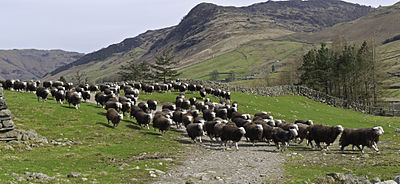Stampede

A stampede is an act of mass impulse among herd animals or a crowd of people in which the herd (or crowd) collectively begins running with no clear direction or purpose.
Species associated with stampede behavior include cattle, elephants, blue wildebeests, walruses, wild horses, rhinoceros, and humans.
Cattle stampedes
Anything unusual may start a stampede. Especially at night, things such as lighting a match, someone jumping off a horse, a horse shaking itself, a lightning strike, a tumbleweed blown into the herd, or "a horse running through a herd kicking at a saddle which has turned under its belly" have been known to cause stampedes.[1]
A large stampede typically eliminates everything in its path. With livestock, cowboys attempt to turn the moving herd into itself, so that it runs in circles rather than running off a cliff or into a river and avoids damaging human life or property. Tactics used to make the herd turn into itself include firing a pistol, which creates noise to make the leaders of the stampede turn.[1]
Animals that stampede, especially cattle, are less likely to do so after having eaten and spread out in smaller groups to digest.[1] To further reduce the risk of stampedes, cowboys sometimes sing or whistle to calm the herds disquieted by nightfall. Those on watch at night avoid doing things which could startle the herd and even distance themselves before dismounting a horse or lighting a match.[2]
Sometimes people purposefully induce cattle to stampede as a component of warfare or hunting, such as some Native Americans, who were known to cause American bison to kill themselves at a buffalo jump.
Human stampedes
Human stampedes most often occur during religious pilgrimages [3] and professional sporting and music events, as these events tend to involve a large number of people. They also occur in times of panic (e.g. as a result of a fire or explosion) as people try to get away. However, more common causes are when the crowd are trying to get toward something as in the former examples, because the crowd is so big that those in the back continue pushing forward not knowing that those in the front are being crushed.[4]
Causes
Deaths from human stampedes occur primarily from compressive asphyxiation and not trampling.[5] This is referred to as crowd crush.[6] The compressive force occurs from both horizontal pushing and vertical stacking.
Examples
- 1883: Victoria Hall disaster where 183 children died rushing to get treats behind a narrow door at the end of a downward staircase
- 1913: Italian Hall disaster 73 people died trying to escape from a false fire alarm at a party in the USA
- June 6, 1941: during a Japanese bombing of Chongqing, China 1000 people were killed in a stampede at the Jiaochangkou tunnel, an access point to an air raid shelter.[7]
- 15 April 1989: Hillsborough disaster: 96 people killed and 766 people wounded trying to get into a football match in England
- 31 December 2014: 2014 Shanghai stampede: 36 people killed and 47 injured in Shanghai stampede during New Year's celebrations [8]
Prevention
This section needs expansion. You can help by adding to it. (January 2013) |
It has been claimed[by whom?] that most major crowd disasters can be prevented by simple crowd management strategies.[5] Human stampedes can be prevented by organization and traffic control, such as barriers. On the other hand, barriers in some cases may funnel the crowd towards an already-packed area, such as in the Hillsborough disaster. Hence barriers can be a solution in preventing or a key factor in causing a stampede. One problem is lack of feedback from people being crushed to the crowd pressing behind – feedback can instead be provided by police, organizers, or other observers, particularly raised observers, such as on platforms or horseback, who can survey the crowd, and use loudspeakers to communicate and direct a crowd.[6]
At the individual level, warning signs of a crowd crush include density of more than four people per square meter, at which each person is being touched on four sides. To avoid or escape from a crowd crush, one is advised to move sideways, particularly between swells.[6]
After the stampede in the Victoria Hall disaster in 1883, a law (still in force as of 2014) was passed in England which required all public entertainment venues to be equipped with doors that open outwards, for example using crash bar latches that open when pushed.[9] Crash bars are required by various building codes.
See also
References
- ^ a b c Fay E. Ward, The cowboy at work, Courier Dover Publications, 2003, ISBN 0-486-42699-8 p. 28
- ^ Fay E. Ward, The cowboy at work, Courier Dover Publications, 2003, ISBN 0-486-42699-8 p. 31
- ^ Illiyas,F.T., Mani,S.K., Pradeepkumar,A.P., Mohan,K. Human stampedes during religious festivals: A comparative review of mass gathering emergencies in India International Journal of Disaster Risk Reduction, Available online 15 September 2013, ISSN 2212-4209, http://www.sciencedirect.com/science/article/pii/S2212420913000459/pdfft?md5=c784794a0b006cffe83a426ad2691c46&pid=1-s2.0-S2212420913000459-main.pdf
- ^ Seabrook, John (7 February 2011). "Crush Point". The New Yorker. Retrieved 1 June 2014.
- ^ a b Fruin, John. The Causes and Prevention of Crowd Disasters. www.crowddynamics.com. Retrieved November 22, 2010.
- ^ a b c How Not To Get Trampled at the Inauguration: Don't go with the flow. By Amanda Ripley, Slate.com Monday, Jan. 19, 2009
- ^ Howard, Joshua (2004). Workers at War: Labor in China's Arsenals, 1937-1953. Stanford University Press. p. 128. ISBN 978-0804748964.
- ^ "New Year's Eve stampede in Shanghai kills dozens". Sydney Morning Herald. 1 January 2015.
- ^ Sarah Stoner (2008). "Children's deaths that shocked the world". Sunderland Echo. Retrieved 13 June 2008.
